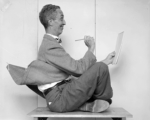This landmark exhibition sheds new light on Norman Rockwell’s art and artistry. Norman Rockwell: Behind the Camera is the first exhibition to explore in depth Rockwell’s richly detailed study photographs, created by the artist as references for his iconic paintings.
Norman Rockwell: Behind the Camera is organized by the Norman Rockwell Museum and author and guest curator Ron Schick. The exhibition reveals a rarely seen yet fundamental aspect of Rockwell’s creative process and unveils a significant new body of Rockwell imagery in an unexpected medium.
“Norman Rockwell was a natural storyteller with an unerring eye for detail,” says Stephanie Haboush Plunkett, deputy director and chief curator of Norman Rockwell Museum. “This groundbreaking exhibition shows how that narrative instinct found its first expression in the artist’s meticulously composed photographs.”
Norman Rockwell: Behind the Camera brings together prints of Rockwell’s study photographs and original paintings and drawings from the permanent collection of Norman Rockwell Museum linked to the photographs on display. The result is a fascinating frame-by-frame view of the development of some of Rockwell’s most indelible images. At the same time, the photographs themselves — painstakingly staged by Rockwell and involving an array of models, costumes, props and settings — are fully realized works of art in their own right.
Curator Schick is the first researcher to undertake a comprehensive study of Norman Rockwell Museum’s newly digitized photography archives. This repository of nearly 40,000 images encapsulates Rockwell’s use of photography over four decades.
“The Kid with the Camera Eye”
Early in his career, Rockwell hired professional models to pose for the characters in his paintings. Beginning in the mid-1930s, however, the evolving naturalism of his work led him to embrace photography, which had increasingly come in vogue as a useful tool for fine artists and a natural ally of commercial illustrators working on tight deadlines. For Rockwell, already known as “the kid with the camera eye,” photography was more than an artist’s aid. The camera brought a new flesh-and-blood realism to his work and opened a window to the keenly observed authenticity that defines his art. Working with friends and neighbors rather than professional models fired Rockwell’s imagination by providing a wide array of everyday faces, while the camera’s ability to capture a fleeting expression or freeze a difficult pose gave him free reign in imagining and constructing his visual narratives and catching, sometimes serendipitously, the nuances of character for which he is beloved.
“Photography has been a benevolent tool for artists from Thomas Eakins and Edgar Degas to David Hockney,” notes Schick. “But the thousands of photographs Norman Rockwell created as studies for his iconic images are a case apart.” Exceptional in scope and detail, these study photographs are distinguished by Rockwell’s gift for character and narrative. And for viewers today, says Schick, they elicit “a haunting sense of déjà vu, mirroring his masterworks in a tangible parallel universe.”
Before committing his ideas to canvas, Rockwell brought them fully to life in studio sessions. He carefully orchestrated each element of his design for the camera, selecting props and locations, choosing and directing his models, even getting in on the action to pose and perform. In fact, Rockwell’s photographic archive reveals that the artist himself is his most frequently captured model. Rockwell staged his photographs much as a film director works with a cinematographer, instructing his cameramen when to shoot, yet never personally firing the shutter. He created dozens or hundreds of photographs for each new subject, sometimes capturing complete compositions and other times jig sawing together separate pictures of individual elements.
Photography brought all the essential elements of Rockwell’s art completely under his direct control. For an artist with a “camera eye,” narrative genius, and commitment to painstaking perfectionism, no better tool can be imagined.
Norman Rockwell: Behind the Camera has been organized by the Norman Rockwell Museum in Stockbridge, Massachusetts. www.nrm.org
Media sponsorship has been provided by Curtis Licensing, a division of The Saturday Evening Post, and by the Norman Rockwell Family Agency.














